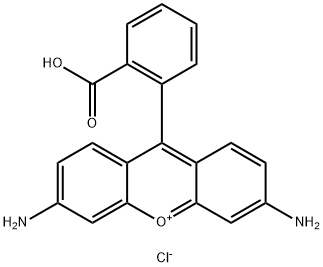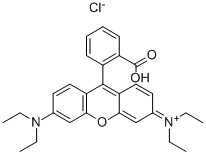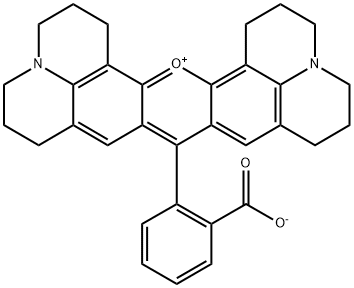Rhodamine 123
Synonym(s):2-(6-Amino-3-imino-3H-xanthen-9-yl)benzoic acid methyl ester
- CAS NO.:62669-70-9
- Empirical Formula: C21H17ClN2O3
- Molecular Weight: 380.83
- MDL number: MFCD00012664
- EINECS: 263-687-8
- SAFETY DATA SHEET (SDS)
- Update Date: 2024-12-18 14:08:52

What is Rhodamine 123?
Description
Rhodamine 123 is a membrane-permeable cationic dye that is readily accumulated within living cells. It is a substrate for the efflux pump P-glycoprotein (P-gp; also known as multidrug resistance protein 1 and ABCB1) and is rapidly exported from cells with functional P-gp. As P-gp is expressed on a population of stem cells known as the side population, rhodamine 123 is used to detect this group of stem cells. Rhodamine 123 also accumulates within mitochondria due to its positive charge and can inhibit oxidative phosphorylation. Rhodamine 123 has excitation/emission maxima of 507/529 nm.
Chemical properties
red-brown to brown or dark green powder
The Uses of Rhodamine 123
Rhodamine-123 is a fluorescent dye most commonly used in flow cytometry as functional reporter for Pgp. Rhodamine 123 (R123), as a typical of P-glycoprotein substrate, was widely used to quantify P-glycoprotein (P-gp) functional efflux activity in vivo. Rhodamine-123 can be used in multiparameter analyses without fluorescence interference in combination with common protein labeling dyes such as PE-Cy5 and AMCA (7-amino-4-methylcoumarin-3-acetic acid).
The Uses of Rhodamine 123
Rhodamine derivative, a fluoresent dye-labeled compound.
The Uses of Rhodamine 123
Fluorescent dye most commonly used as functional reporter in flow cytometry.
The Uses of Rhodamine 123
Rhodamine-123 lycoprotein (P-gp) functional efflux activity in vivo. Rhodamine-123 PE-Cy5 and AMCA (7-amino-4-methylcoumarin-3-acetic acid).
The Uses of Rhodamine 123
Useful as a laser dye and to have selective cell growth effects. Mitochondrial specific fluorescent dye and substrate for P-glycoprotein.
What are the applications of Application
Rhodamine 123 is a cationic dye that emits a green fluorescence
in vitro
rhodamine 123, which was identified as a member of the rhodamine family of flurone dyes, was used to examine membrane transport by the abcb1 gene product, mdr1. previous study determined the λmax for excitation and emission for rhodamine 123 in commonly used solvents and extraction buffers, indicating that the fluorescence of rhodamine 123 was highly dependent on the chemical environment. the optimal parameters are 1% methanol in hbss. in addition, the uptake of rhodamine 123 into cells was via both passive and active processes, and this occurred mainly by oatp1a2-mediated transport. furthermore, this previous study quantified the intracellular sequestration and metabolism of rhodamine 123, showing that these were both cell line-dependent factors that might influence the interpretation of transport assays [1].
References
[1] samantha forster et al. characterization of rhodamine-123 as a tracer dye for use in in vitro drug transport assays. plos one. 2012; 7(3): e33253.
Properties of Rhodamine 123
| Melting point: | 235 °C |
| Density | 1.2224 (rough estimate) |
| refractive index | 1.6500 (estimate) |
| storage temp. | Hygroscopic, -20°C Freezer, Under inert atmosphere |
| solubility | ethanol: 20 mg/mL, clear, red |
| form | Powder |
| color | Red-brown to brown or dark green |
| Water Solubility | Partially soluble |
| λmax | 501 nm, 507 nm |
| BRN | 6030951 |
| Stability: | Hygroscopic |
| Biological Applications | Measuring membrane potential; detecting cancer cells,spores,prostate cancer,stress biomarkers; treating disc degenerative disease,epilepsy,erectile dysfunction; apoptosis assays; tumor cell multidrug resistance assay; implantable |
| Major Application | Colored bubbles; color
filters; liquid crystal displays; light-emitting diodes;
luminescent materials;nanophotonic composites;
paints; semiconductor electrodes;solar cells |
| CAS DataBase Reference | 62669-70-9(CAS DataBase Reference) |
| EPA Substance Registry System | Xanthylium, 3,6-diamino-9-[2-(methoxycarbonyl)phenyl]-, chloride (62669-70-9) |
Safety information for Rhodamine 123
| Signal word | Warning |
| Pictogram(s) |
 Exclamation Mark Irritant GHS07 |
| GHS Hazard Statements |
H302:Acute toxicity,oral |
| Precautionary Statement Codes |
P264:Wash hands thoroughly after handling. P264:Wash skin thouroughly after handling. P270:Do not eat, drink or smoke when using this product. P501:Dispose of contents/container to..… |
Computed Descriptors for Rhodamine 123
| InChIKey | MYFATKRONKHHQL-UHFFFAOYSA-N |
New Products
(S)-3-Aminobutanenitrile hydrochloride 4-Methylphenylacetic acid N-Boc-D-alaninol N-BOC-D/L-ALANINOL Tert-butyl bis(2-chloroethyl)carbamate 3-Morpholino-1-(4-nitrophenyl)-5,6-dihydropyridin- 2(1H)-one Furan-2,5-Dicarboxylic Acid Tropic acid 1-Bromo-3,5-Di-Tert-Butylbenzene S-2-CHLORO PROPIONIC ACID ETHYL ISOCYANOACETATE 2-Bromo-1,3-Bis(Dimethylamino)Trimethinium Hexafluorophosphate 4-IODO BENZOIC ACID 3-NITRO-2-METHYL ANILINE 1-(2,4-DICHLOROPHENYL) ETHANAMINE (2-Hydroxyphenyl)acetonitrile 4-Bromopyrazole 2-(Cyanocyclohexyl)acetic acid 4-methoxy-3,5-dinitropyridine 1-(4-(aminomethyl)benzyl)urea hydrochloride 2-aminopropyl benzoate hydrochloride diethyl 2-(2-((tertbutoxycarbonyl)amino) ethyl)malonate tert-butyl 4- (ureidomethyl)benzylcarbamate Ethyl-2-chloro((4-methoxyphenyl)hydrazono)acetateRelated products of tetrahydrofuran


![2,3,6,7,12,13,16,17-octahydro-9-(trifluoromethyl)-1H,5H,11H,15H-xantheno[2,3,4-ij:5,6,7-i'j']diquinolizin-18-ium perchlorate](https://img.chemicalbook.in/CAS/20180808/GIF/63561-42-2.gif)

![9-Cyano-2,3,6,7,12,13,16,17-octahydro-1H,5H,11H,15H-xantheno[2,3,4-ij:5,6,7-i'j']diquinolizin-18-ium perchlorate](https://img.chemicalbook.in/CAS/20180808/GIF/137993-41-0.gif)

![9-(2-carboxyphenyl)-2,3,6,7,12,13,16,17-octahydro-1H,5H,11H,15H-xantheno[2,3,4-ij:5,6,7-i'j']diquinolizin-18-ium perchlorate](https://img.chemicalbook.in/CAS/20211123/GIF/72102-91-1.gif)

You may like
-
 Rhodamine 123 95% CAS 62669-70-9View Details
Rhodamine 123 95% CAS 62669-70-9View Details
62669-70-9 -
 Rhodamine 123 CAS 62669-70-9View Details
Rhodamine 123 CAS 62669-70-9View Details
62669-70-9 -
 Rhodamine 123 CAS 62669-70-9View Details
Rhodamine 123 CAS 62669-70-9View Details
62669-70-9 -
 1975-50-4 98%View Details
1975-50-4 98%View Details
1975-50-4 -
 2-HYDROXY BENZYL ALCOHOL 98%View Details
2-HYDROXY BENZYL ALCOHOL 98%View Details
90-01-7 -
 2-Chloro-1,3-Bis(Dimethylamino)Trimethinium Hexafluorophosphate 221615-75-4 98%View Details
2-Chloro-1,3-Bis(Dimethylamino)Trimethinium Hexafluorophosphate 221615-75-4 98%View Details
221615-75-4 -
 14714-50-2 (2-Hydroxyphenyl)acetonitrile 98+View Details
14714-50-2 (2-Hydroxyphenyl)acetonitrile 98+View Details
14714-50-2 -
 118753-70-1 98+View Details
118753-70-1 98+View Details
118753-70-1